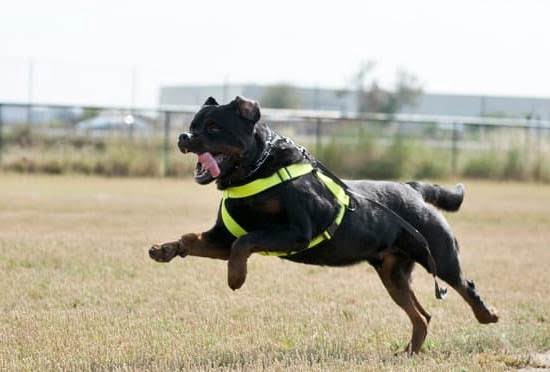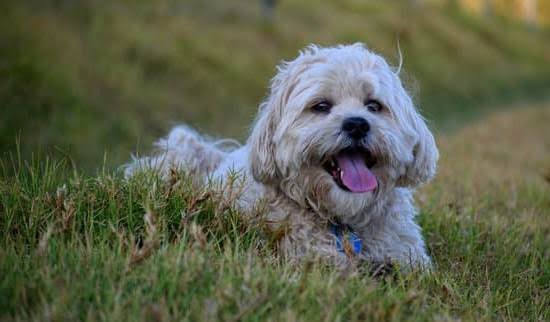Introduction
It is important to have a clear understanding of what is meant by “guarding” before attempting to train your dog not to guard humans. Guarding is a form of behavior in which the dog displays aggressive behaviors towards others in order to protect its human family or those living in its territory. This includes barking intensely, growling, lunging, and even biting if provoked. The guarding behavior must be carefully identified and addressed to ensure both the safety of humans and animals involved.
In order to successfully train dogs not to guard their humans or territory, it is necessary to first understand why they are doing so and address underlying issues that are causing the guarding behavior. It helps to understand that this is innate with canines and may be rooted in a drive for protection or being overly possessive of what they perceive as theirs. Through careful management, training, socialization, desensitization and owner education, it can be possible to find a balance between safety for all involved and learning better behaviors for the canine companion.
To begin addressing guarding issues it helps start by understanding your canine’s body language so that when you see signs of potential guarding behaviors you can intervene quickly before any serious incident occurs. Depending on how severes the guarding reaction has become or is occurring from an early age, different training methods may need to be employed such as reinforcement-based positive reinforcement (RBP), desensitization exercises and anti-guarding exercises/games focussing on rewarding desired behaviors rather than punishing unwanted behaviors.
Additionally, consistent supervision of interactions between people and animals will go a long way in creating appropriate associative learning within your canine companion which should help reduce guarding reactions over time – allowing your canine friend the opportunity to learn proper boundaries when interacting with others while keeping everyone safe.
Causes of Guarding Behavior in Dogs
Dogs who guard humans are typically displaying territorial behavior or fear-based aggression. Territorial behavior may be the result of an innate need to protect what they deem their own, while fear-based aggression is often a symptom of lacking socialization and misunderstanding their place in an unfamiliar environment. Territorial guarding behavior may also stem from past abuses and neglect that cause a dog to become overly protective towards its owners and space as a result of anxiety. In some instances, defending and guarding can even be seen as a way of seeking attention, as the dog might feel neglected if it isn’t getting enough affection or stimulation.
The most important part in successfully training your dog to stop guarding humans is to look for patterns in the behavior and proactively address them. If you identify your dog’s body language communicating discomfort or distress when around particular people, make sure they get familiarized with that person with positive reinforcement allowances before allowing them near your pet again. Teaching basic obedience commands like ‘sit’ ‘stay’ ‘down’ can help you quickly break your pet’s focus away from potential threat stimuli or interlopers so that he doesn’t have time to act out or bark at accusations unnecessarily. The key is for your dog to understand that aggressive behavior is not okay and any display could lead to consequences, but does not need defensive reaction risk escalation on his part and will ultimately discourage his instinctive tendencies towards overzealousness and domination.
Setting Expectations and Building Trust
When training a dog to stop guarding humans, it is important to set expectations from the start and build trust in your relationship. Establishing clear rules and limits can help dogs understand when their guarding behavior is appropriate and when it’s not. Consistency will help assure them that their humans are in control and that they can trust them. To set expectations, create verbal cues for different behaviors, such as “sit” or “down” for basic commands or a whistle blow followed by a spoken command if distances are needed. Teaching these rules should be reinforced with rewards such as treats, verbal praise, and physical affection.
In addition to making sure that limits are clear, it is also important to build trust between human and pet through mutual respect. This can be done by being consistent in interactions and providing positive reinforcement when your dog behaves appropriately. Respect its space – ensure that you always ask permission before petting or handling your dog – avoid eye contact since this may appear aggressive – remain calm while communicating verbally or with body language – ensure children know how to properly interact too – take timeouts if your dog exhibits sign of aggression. Most importantly, do not punish your dog when it guards; instead focus on positively reinforcing good behaviors with pets treats, snuggles and verbal praise.
Positive Reinforcement Strategies
Positive reinforcement strategies have been proven to provide the most effective results when it comes to training your dog. To help your dog stop guarding you, create a positive reward system; giving an appropriate treat for desired behavior can be very useful and motivating. Additionally, it’s important to desensitize your pup to any noise or stimulus that may cause them to guard you more. Do this by patiently exposing your pup gradually to the stimuli and rewarding them whenever they remain calm and content. During their training session, set clear limits regarding what type of behavior is acceptable and not acceptable, such as telling them off for growling or having them sit next to you instead of in front of you. Lastly, be sure to practice consistency; whatever method you decide on, stick with it and follow through daily so that your pup understands what behavior is desired.
Establishing Safe and Respectful Playing Areas
One way to train a dog to stop guarding humans is by establishing safe and respectful playing areas throughout the house or yard. You should set up different sections of the house or yard to clearly define safety and privacy zones for each person in the family or visiting the home. Make sure these zones are off-limits to the dog at all times. The key is setting boundaries so that your pup knows who is allowed access to these areas and who gets to enter them first.
To teach your dog that it’s not acceptable to guard humans, start by celebrating their presence when you’re in a room together. Play with toys and laugh together, keeping any physical contact light, but entertaining. As you gain trust with your pup, invite members of your family into the area for short visits with you two, accompanied by treats for good behavior. Every time someone new arrives, make sure your pup is on his best behavior and reward him for not guarding humans during visitor interactions. Eventually, he will understand that no one poses any threat when around people he doesn’t know.
Defining Your Dog’s Space
If you want to train your dog to stop gaurding humans, it is important to define their space. You need to start by giving your dog a comfortable and safe spot (like a dog bed), where they are not allowed to be disturbed. Then you should make sure every person in the house is aware of the boundaries and will stay out of that area. Whenever someone comes into the house, show them that they are not allowed within your dogs space by keeping them at the edge of it and encouraging them to stay there. In addition, try having visitors toss treats when they come in so that your pup learns it’s ok if people enter its space so long as it gets something in return. Lastly, if at any time your dog starts behaving aggressively in their space, firmly tell them no and redirect their attention back somewhere else. With consistent reinforcement and clear expectations, your pup will eventually learn to respect their boundaries as well as those of people entering the home.
Teaching Impulse Control
It is important for dog owners to train their pup to have impulse control and learn how to curb any guarding instincts that can cause problems for both the human and the dog. To encourage proper impulse control, owners should start with basic obedience training. This should include teaching the pup basic commands, such as sit, stay, come and leave it. Training these commands allows you to gain the pup’s trust and help them understand that they should listen to you. Another way of encouraging impulse control is by practicing reinforcement exercises with your puppy. This could be as simple as rewarding them when they follow your command and using verbal corrections if they don’t obey your instructions. It is also beneficial to practice impulse control exercises when around people other than yourself to make sure your pup has no problem associating being obedient with different people or environments. To do this, you may set up situations where someone approaches your pup in a respectful manner while you reward them for displaying appropriate behavior (sitting calmly or staying away). In addition to this, whenever possible redirect your dogs focus elsewhere when it feels threatened or jumps up on someone uninvited – playing games or giving treats are great ways to distract them from potential issues.
Teaching Your Dog to Disengage
For dogs with an issue of guardiness, an important part of training is teaching the dog when and how to disengage. This means teaching the dog to voluntarily move away from the person or thing it finds interesting at that time. Teaching your dog when and how to disengage provides the dog with a way out when it gets too involved in something that may alarm or upset another person.
The best way to do this is by teaching your dog cues such as “go away” or “leave it”. Once you have established these cues, practice them regularly in a range of different situations. Begin with low-intensity and less emotionally stimulating places such as calm indoor settings, then slowly move up to include more challenging walks and higher intensity environments like parks with other people around. Be sure to reward the dog for following commands right away so they understand that their response was correct. In addition, be sure your corrections are consistent; otherwise your dog may not understand why they should listen to the command ‘go away’ when they are feeling protective or aggressive.
Once you have trained this behavior over several weeks, start practicing turning yourself sideways to create distance between you and what’s inciting guardiness from your pup. Physically blocking off access can be seen as confrontational, which could trigger defensive responses from them instead of reducing anxiety levels on approach. Keep doing positive reinforcement for any non-defensive behaviors like sitting quietly or staying on a mat near the guest or whatever is inciting guardiness; this will help reinforce positive behavior over time and adjust negative behavioral instincts based upon environmental circumstances.
Counter-Conditioning Your Dog to Neutral Stimuli
Counter-conditioning your dog to neutral stimuli means training them to have a different reaction when they are around people or animals. You can start by using treats and toys as rewards for good behavior and ignoring his barking behavior. Show him that you have something he wants, like a toy or treat, but only reward him with it after he has calmed down and is no longer showing signs of guard-dog behavior. This will eventually condition him to associate the presence of humans or animals with something positive instead of provoking an aggressive reaction.
To increase the effectiveness of this method, you can also get someone else (such as a family member) to help out with the training. Have them stand a few feet away so that your dog becomes gradually acclimated to having people present around them and reward the dog when it is not displaying guard-dog behavior in front of others. Eventually, your dog should become more relaxed in the presence of other people or animals as long as you keep rewarding them for calm behavior.
Teaching Triggered Words and Phrases
The first step to train your dog to stop guarding humans is teaching it “triggered words and phrases”. This involves giving the dog a specific cue phrase that signals to it that it should stop its behavior. For example, you could use the phrase “It’s okay” in a calm voice whenever your dog becomes aggressive or agitated around people. This phrase should be said every time the same type of behavior occurs so that your dog will start to associate it with being commanded to stop and relax. Additionally, this phrase can also be used when praising him for stopping on his own or following other commands. Once the skill is mastered, gradually introduce a new word or phrase like “easy” or “all done” as further cues for him to relax and release any tension he may have been holding when guarding people.
Learning Alternative Behaviors
When training a dog to stop guarding humans, it is important to teach them alternative behaviours. This will help redirect their urge to guard and focus them instead on activities that are more acceptable and rewarded. Start by teaching basic obedience commands such as sit, stay and come when called, as these can be useful during moments of guarding. Positive reinforcement is important and reward-based training should be used. Things like treats or toys should be kept in the pocket when telling your dog to do certain behaviours.
Another technique that can help integrate new behaviours is desensitization. For example, if your dog is protective over you when strangers come near, expose the dog gradually by introducing one stranger at a time from a distance, letting the reference person give treats or play with the animal when he or she behaves appropriately in their presence. Over time as the dog becomes more relaxed, move closer and have more people involved at once.
Try engaging in some positive distractions like playing with toys or participating in interactive games while family members or guests are present which will shift the focus away from guarding behaviour. With patience and consistency you will eventually achieve desired results and enjoyed being around humans without feeling the need to guard them all the time!
Troubleshooting Common Training Challenges
When training a dog to stop guarding humans, it is important to identify the underlying issue that is causing the dog to guard in the first place. Common reasons why dogs might begin to guard includes fear and insecurity, over-possessiveness, learned behavior, lack of socialization and resource guarding.
The best way to address these issues is through classical conditioning. This means developing positive associations with a desired behavior and providing treats or rewards each time your pup feels comfortable in a certain situation they were once uncomfortable with. For example: If your dog guards people when they approach you on walks, gradually introduce them one person at a time and provide treats every time he or she warms up to someone instead of guarding against them. Start slowly until your pup becomes comfortable with that person approaching you and introducing more people once this stage has been mastered.
Another helpful technique is desensitization. This involves exposing your pup to triggers that cause them stress related to the guarding and reinforcing calm behavior with reward or affection. You should start with non-threatening versions of what causes the dog distress; for instance if your pup guards over their food, start by standing further away from their bowl without interacting and slowly get closer until your pup does not react negatively anymore; then treat!
If these techniques still don’t work in educating your pup better manners when it comes to guarding humans, don’t fear –consulting an animal behavior expert is always an option! They can assess how serious the problem is and recommend specific strategies geared towards helping you train your beloved pet over time.
Conclusion
The key to successfully training your dog to stop guarding humans is patience and consistency. Providing clear verbal cues or commands from the start will be important in ensuring that your dog understands your expectations. Establishing a routine of rewards for good behavior, as well as regular and consistent enforcement of rules, is essential in establishing appropriate behavior patterns.
You should also ensure that everyone who interacts with your dog is on the same page when it comes to how to deal with any form of protection or guard-dog behaviors displayed by your pup. Don’t forget that these behaviors are normal responses for a pup trying to protect their humans – so properly educating those around you about canine body language and communication signals can help them know what’s really happening during certain moments and learn how best to interact with your pup. Positive reinforcement techniques can also be used when addressing any undesirable behaviors, such as providing treats and praise whenever your pup shows positive interactions – such as not dwelling on strangers’ approaches or sniffing around without aggression.
By creating an environment full of love, security, and most importantly, trust between you and your pup, you can significantly reduce the chances of guard-dog behavior surfacing. Lastly but certainly not least important, it’s vital that all family members know the correct response protocol in instances where guard-dog behavior occurs – striking an appropriate balance between firmness, empathy and understanding are essential components here! With these tips you’ll soon find yourself living happily alongside a dog who no longer guards humans!

Welcome to the blog! I am a professional dog trainer and have been working with dogs for many years. In this blog, I will be discussing various topics related to dog training, including tips, tricks, and advice. I hope you find this information helpful and informative. Thanks for reading!





